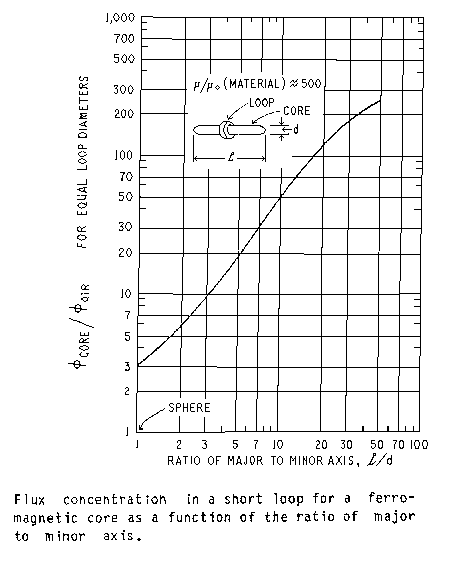MAGNETIC MOMENTS, Number 4
FERRITE CORE ANTENNAS
(originally printed in Speleonics 6, Fall 1986, p.10)
By Ian Drummond
Most people are familiar with the ferrite loop antennas used in transistor radios, and with their directional properties. Can such antennas be profitably used in cave radio designs? What are the effects of putting a ferrite core in a coil of wire?
The primary effect is to increase the magnetic flux threading the coil of wire, thus increasing the effective area of the coil. Since the transmitted field intensity is proportional to the area of the transmitting loop (Mag. Moments #1), and the power absorbed in reception is proportional to the area squared (Mag. Moments #3) the use of ferrite cores at first looks very promising.
When using magnetic materials, the correct mix of ferrite must be chosen for the frequency of operation. Using a material at too high a frequency will cause high eddy-currents and inefficient operation. Using a mix below its frequency range will mean the magnetic permeability (the ability to concentrate the magnetic flux) is much lower than it could be. Materials suitable for the range from 1 kHz up to 1 MHz have bulk permeability in the range 500 - 5000.
Unfortunately this does not mean that the effective area of a loop can be increased by a factor of 5000 by just adding a chunk of ferrite! The problem is that a real core of finite size is demagnetized by the magnetic poles formed at the ends of the core. For materials with a bulk permeability greater than 500, the effective permeability (or flux concentration) depends only on the length/diameter ratio of the core and is shown in the graph (taken from VLF Radio Engineering by A. D. Wait, Pergamon Press)

For example, Amidon Assoc. sells several ferrite rods of R33 material with a bulk permeability of 800, for operation between 1 kHz and 1 MHz. (Note, Amidon has moved since the original article, but is still selling small quantities to experimenters. They are in Santa Ana, California at (714)850-4660, fax (714)-850-1163)
The biggest rod in their catalogue is R33-075-1200 which is 12 inches (30.5 cm) long by 0.75 inch (1.9 cm) diameter. (Calm down in the back, this is strictly an electronics catalogue!).
The L/D radio is 16, and from the graph, the effective permeability is about 90. So the effective area of an antenna made using this rod is 90 x 3.14 x 0.375 = 40 in2 (356 cm2). This is the same area an air-cored loop 7 inches (18 cm) In diameter.
In this case, the use of the ferrite core does give an antenna that is more compact than an air-core loop of the same "size," but that size is still very small compared to loops in common use, which range from 15 - 48 or more inches (38 - 122 cm) in diameter. This reduction in size has been obtained at the cost of weight, about 450 g (1 lb); and dollars, about US $18.00 to purchase the core.
Thus, the use of ferrite-core antennas for transmission would only seem to give an advantage for short-range radios where small size is very important.
While the primary interest in using a ferrite core is to increase the effective area of a coil, the ferrite will also increase the inductance of the antenna. This will raise the Q and narrow the bandwidth, increase voltages and input impedances to the antenna, among other effects. These may or may not be desirable effects. If anyone is interested in designing ferrite antennas, the design program for air-cored loops published in Speleonics #2 is easily modified to accommodate them:
Change line 780 MU = 1 to request input of MU for the core.
Change line 1070 to read NIA=N*AMPS*AREA*MU.
Thatís it!
Return to the Top of the Page
Copyright © 2000 Communications & Electronics Section of the NSS, Inc. - All Rights Reserved.